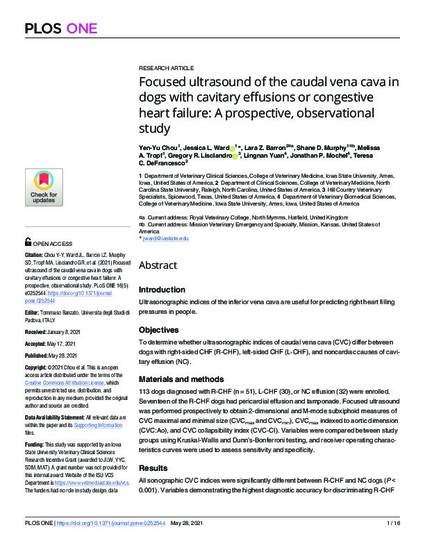
Introduction: Ultrasonographic indices of the inferior vena cava are useful for predicting right heart filling pressures in people.
Objectives: To determine whether ultrasonographic indices of caudal vena cava (CVC) differ between dogs with right-sided CHF (R-CHF), left-sided CHF (L-CHF), and noncardiac causes of cavitary effusion (NC).
Materials and methods: 113 dogs diagnosed with R-CHF (n = 51), L-CHF (30), or NC effusion (32) were enrolled. Seventeen of the R-CHF dogs had pericardial effusion and tamponade. Focused ultrasound was performed prospectively to obtain 2-dimensional and M-mode subxiphoid measures of CVC maximal and minimal size (CVCmax and CVCmin), CVCmax indexed to aortic dimension (CVC:Ao), and CVC collapsibility index (CVC-CI). Variables were compared between study groups using Kruskal-Wallis and Dunn’s-Bonferroni testing, and receiver operating characteristics curves were used to assess sensitivity and specificity.
Results: All sonographic CVC indices were significantly different between R-CHF and NC dogs (P < 0.001). Variables demonstrating the highest diagnostic accuracy for discriminating R-CHF versus NC were CVC-CI <33% in 2D (91% sensitive and 96% specific) and presence of hepatic venous distension (84% sensitive and 90% specific). L-CHF dogs had higher CVC:Ao and lower CVC-CI compared to NC dogs (P = 0.016 and P = 0.043 in 2D, respectively) but increased CVC-CI compared to the R-CHF group (P < 0.001).
Conclusions: Ultrasonographic indices of CVC size and collapsibility differed between dogs with R-CHF compared to NC causes of cavitary effusions. Dogs with L-CHF have CVC measurements intermediate between R-CHF and NC dogs.
Available at: http://works.bepress.com/jessica-ward/12/

This article is published as Chou Y-Y, Ward JL, Barron LZ, Murphy SD, Tropf MA, Lisciandro GR, et al. (2021) Focused ultrasound of the caudal vena cava in dogs with cavitary effusions or congestive heart failure: A prospective, observational study. PLoS ONE 16(5): e0252544. DOI: 10.1371/journal.pone.0252544. Posted with permission.